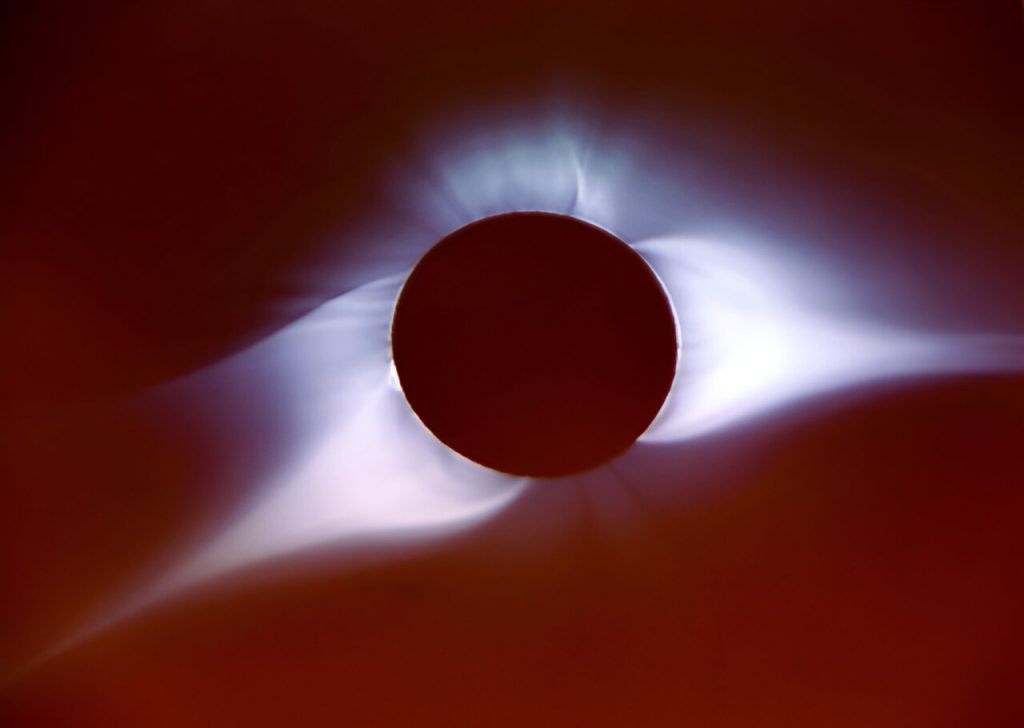The corona, or the Sun’s atmosphere, is a region that extends 8 million kilometers above the Sun’s surface and is characterized by unusually high temperatures. Credit: CSPAR
in New Research Published in Astrophysical JournalA researcher at the University of Alabama in Huntsville (UAH), part of the University of Alabama System, has investigated a key aspect of a phenomenon called kinetic Alfvén waves (KAWs), providing new insight into an age-old solar physics mystery.
Saeed Ayaz, a graduate research assistant at the UAH Center for Space Plasma and Atmospheric Research (CSPAR), has investigated the potentially pivotal role of KAWs in heating the solar corona, bringing science a step closer to solving the mystery of why the corona is many times hotter than the surface of the sun itself.
“For decades, Alfven waves have proven to be the best candidate for transporting energy from one place to another,” Ayaz said, pointing out the potential role of Alfven waves in driving coronal heating.
“This paper takes a new approach to modeling Energy Particles Space plasma observed by satellites such as Viking and Freya has revealed how the electromagnetic energy of the waves interacts with particles and is converted into heat during the damping process as the waves travel through space.
“Our study will investigate the disturbed electromagnetic field in the solar atmosphere, the Poynting magnetic flux vector, and the power delivery rate of KAW.”
The corona, or the Sun’s atmosphere, is a mysterious region surrounding our mother star that extends far beyond the Sun’s visible disk, from the Sun’s surface to about 8 million kilometers above the surface. But the corona is characterized by unusually high temperatures, and its mysteries have fascinated astrophysicists for nearly 70 years.
“Saeed is one of those outstanding students just beginning his research career,” said Dr. Gary Zank, CSPAR director and Aerojet Rocketdyne dean at UAH’s College of Space Sciences. “His abiding interest in Alfven waves began while working with his mentor, Dr. Imran A. Khan, as a student in Pakistan and has now led to his study of Alfven waves at the very small scale of plasmas, the so-called kinetic scale.
“His research is about how energy magnetic field “It is transformed into heating plasma, which contains charged particles such as protons and electrons. One reason Said’s work is important is that we still don’t know why the temperature of the sun’s atmosphere is over 1 million degrees, while the surface temperature of the sun is a relatively low 6,500 degrees.”
Kinetic Alfven waves are abundant throughout the plasma universe and are vibrations of ions and magnetic fields moving through the solar plasma. These waves are formed by the motion of the photosphere, the outer shell of the Sun that radiates visible light.
“My primary interest in these waves was sparked by the launch of the Parker Solar Probe and the Solar Orbiter. These missions raised the important question of how the solar corona heats up,” Ayaz said. “Until now, no spacecraft mission has provided predictions on these phenomena close to the Sun, specifically within the range of 0 to 10 solar radii. Our primary focus is to investigate heating by KAWs within these ranges. Solar corona“
“We focused on the heating and energy exchange facilitated by KAWs,” the researchers said. “The reason these waves have attracted so much interest is their ability to transport energy. Observational data from numerous spacecraft and theoretical investigations have consistently demonstrated that KAWs dissipate while propagating through space and contribute to heating the solar corona.”
For these Unique propertiesWaves provide an important mechanism for transferring energy and are critical to understanding the energy exchange between electromagnetic fields and plasma particles.
“KAWs operate on small motion scales, supporting parallel electric and magnetic field fluctuations and allowing energy transfer between the wave field and plasma particles through a phenomenon called the Landau interaction,” Ayaz says.
“In this study, we exploit and investigate the Landau damping mechanism, which occurs when the speed of a particle moving parallel to the wave is comparable to the phase speed of the wave.”
Landau damping is the exponential decrease in the intensity of certain waves in a plasma as a function of time. “When a particle interacts with a wave, it either gains or loses energy. This is called a ‘resonant state,'” Ayaz says.
“This causes the waves to either transfer energy to the particles or gain energy from them, causing them to either decay or grow. In our study, we find that KAWs dissipate quickly and then completely transfer their energy, in the form of heating, to the plasma particles. Energy Transfer Accelerating particles over longer spatial distances, plasma“
The analytical insights gained from this study are: Solar atmosphereIn particular, it highlights the important role played by non-thermal particles in the heating process.
For more information:
Syed Ayaz et al. “Heating of the solar corona by kinetic Alfven waves” Astrophysical Journal (2024). Posted: 10.3847/1538-4357/ad5bdc
Provided by
University of Alabama-Huntsville
Quote: Why the solar corona is much hotter than the sun’s surface (July 29, 2024) Retrieved July 30, 2024 from https://phys.org/news/2024-07-solar-corona-hotter-sun-surface.html
This document is subject to copyright. It may not be reproduced without written permission, except for fair dealing for the purposes of personal study or research. The content is provided for informational purposes only.


